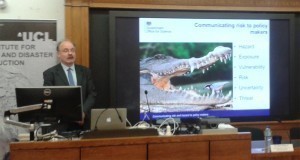Last week I had an interesting and engaging conversation with a group of young people that were just starting to make their own Emergency Preparedness plans both for their families and their fledgling businesses when the topic of hazards and risks resulted in:
“… but risk is the same as hazard? How are they different?”
Indeed, it’s a common enough confusion, mostly because risk is often defined in terms of hazards so fuzzyness creeps in. Also, a number of different definitions and understandings exist, all depending on who you ask and what their frame of reference is. That does not help practical people that want clear guidance fast.
Luckily, I recently attended a brilliant conference on Risk and Disaster Reduction in London, the UCL IRDR 5th Annual Conference where Sir Mark Walport in his keynote speech on communicating risk and hazards gave an excellent example which I hope he won’t mind me passing on to you. The imagery he used was this:
What do you see? A massive hazard. But how about risk? What exactly do you know about the CONTEXT in the above?
How about now?
Well, better him than me I’d say for I’m not that brave but you certainly begin to see where this is going:
Talking about hazards is necessary but not sufficient
(as scientists love to point out) and that’s precisely why it matters to draw the distinction.
In order to build better preparedness and resilience, we need to continuously assess and monitor risk, meaning the probability or likelihood of (often complex) scenarios as well as the severity of impact over time. As per Sir Mark’s slide, this concerns

Professor Sir Mark Walport; Government Chief Scientific Adviser and Head of Government Science and Engineering Profession at UCL IRDR 2015
– hazard: a source of harm or damage
– threat: an intent or determination to inflict harm or damage
– exposure: the condition of being exposed to harm or damage
– vulnerability: the susceptibility to being harmed or damaged
– uncertainty: current degree of knowledge as unknown or doubtful
To get a better idea what risk assessments and a risk matrix can look like
have a look at the National Risk Register 2015, page 11. Naturally, these high priority risks as currently identified by the UK government change and shuffle in line with the changing situation in the UK and around the world. Keep an eye on regularly published updates and consider the risks particular to your own environment and situation, also in line with any information your local resilience forum can provide. You may also find our extensive preparedness resources useful.
That’s exactly where I left the group of young entrepreneurs and family men and women. However, as with them I also want to stress here:
making a plan is necessary but not sufficient
for – and yes, you’ve heard it all before And finally, are you still curious about The Crocodile and the Plover Bird? It’s a good story.
And finally, are you still curious about The Crocodile and the Plover Bird? It’s a good story.
Have a great week!
Monika
Tweet
thank you for sharing and helping raise awareness for Emergency Preparedness!
For more EVAQ8 blog simply use the right hand navigation. For emergency kits and practical resources use the top navigation. For FREE resources head over to our Preparedness Hub and find out why we use humour. If you like this post, please share it to help raise awareness for Emergency and Disaster Preparedness. Thank you!
Find EVAQ8 on social media, like and follow us!





Interesting post with clear examples and excellent links to resources. You tick all the right boxes. Brilliant blog!!
Simply a good, interesting and relevant piece. Thanks for the blog!
Love your approach. Excellent blog!!
I was looking through some of your blog posts and found them all very informative and relevant ! Keep on posting
Really glad I landed on your blog. Brilliant content, thanks!
Nice to see that you’re pulling quality info into a public blog like this. Good job spreading the word 🙂
I really like your blog. Always informative and ever so useful!